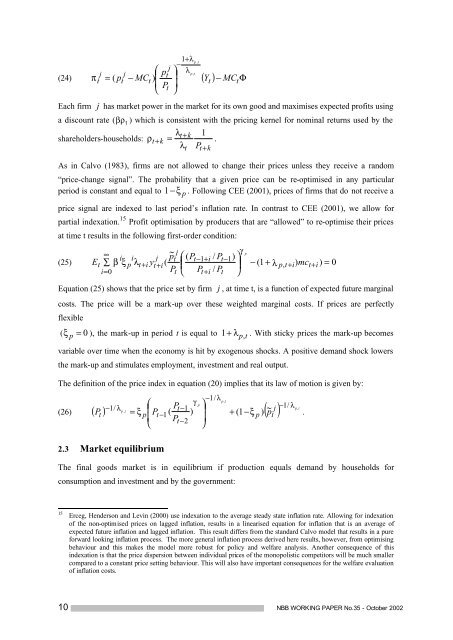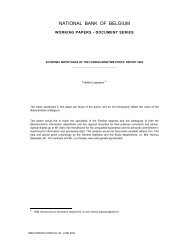An estimated dynamic stochastic general equilibrium model of the ...
An estimated dynamic stochastic general equilibrium model of the ...
An estimated dynamic stochastic general equilibrium model of the ...
You also want an ePaper? Increase the reach of your titles
YUMPU automatically turns print PDFs into web optimized ePapers that Google loves.
jt⎛⎜ p− MCtt )⎜⎝Ptp,t(24) ( ) − Φπ= ( pjtj⎞⎟⎟⎠1+λ−λp , tYtMCEach firm j has market power in <strong>the</strong> market for its own good and maximises expected pr<strong>of</strong>its usinga discount rate ( βρ t ) which is consistent with <strong>the</strong> pricing kernel for nominal returns used by <strong>the</strong>λshareholders-households:t+k 1ρ t+ k =.λtP t + kAs in Calvo (1983), firms are not allowed to change <strong>the</strong>ir prices unless <strong>the</strong>y receive a random“price-change signal”. The probability that a given price can be re-optimised in any particularperiod is constant and equal to 1 −ξ p . Following CEE (2001), prices <strong>of</strong> firms that do not receive aprice signal are indexed to last period’s inflation rate. In contrast to CEE (2001), we allow forpartial indexation. 15 Pr<strong>of</strong>it optimisation by producers that are “allowed” to re-optimise <strong>the</strong>ir pricesat time t results in <strong>the</strong> following first-order condition:∞~ jγpi i j p ( / )(25) (t ⎛ P 1 1 ⎞⎜t−+ i PEt−t ∑ β ξ p λt+ i y t + i⎟ − (1 + λ p,t+i)mct+i)= 0i=0Pt⎝ Pt+ i / Pt⎠Equation (25) shows that <strong>the</strong> price set by firm j , at time t, is a function <strong>of</strong> expected future marginalcosts. The price will be a mark-up over <strong>the</strong>se weighted marginal costs. If prices are perfectlyflexible( ξ p = 0 ), <strong>the</strong> mark-up in period t is equal to 1+ λ p, t . With sticky prices <strong>the</strong> mark-up becomesvariable over time when <strong>the</strong> economy is hit by exogenous shocks. A positive demand shock lowers<strong>the</strong> mark-up and stimulates employment, investment and real output.The definition <strong>of</strong> <strong>the</strong> price index in equation (20) implies that its law <strong>of</strong> motion is given by:−Pt−1/λ⎛γP ⎞j −1/λ= ξ ⎜p Pt1 ( ) ⎟−+ (1 −ξp ) pt.⎜ Pt−2⎟⎝⎠p,tp1 / λt−1~p tt(26) ( ) ( ) p,,2.3 Market <strong>equilibrium</strong>The final goods market is in <strong>equilibrium</strong> if production equals demand by households forconsumption and investment and by <strong>the</strong> government:t15Erceg, Henderson and Levin (2000) use indexation to <strong>the</strong> average steady state inflation rate. Allowing for indexation<strong>of</strong> <strong>the</strong> non-optimised prices on lagged inflation, results in a linearised equation for inflation that is an average <strong>of</strong>expected future inflation and lagged inflation. This result differs from <strong>the</strong> standard Calvo <strong>model</strong> that results in a pureforward looking inflation process. The more <strong>general</strong> inflation process derived here results, however, from optimisingbehaviour and this makes <strong>the</strong> <strong>model</strong> more robust for policy and welfare analysis. <strong>An</strong>o<strong>the</strong>r consequence <strong>of</strong> thisindexation is that <strong>the</strong> price dispersion between individual prices <strong>of</strong> <strong>the</strong> monopolistic competitors will be much smallercompared to a constant price setting behaviour. This will also have important consequences for <strong>the</strong> welfare evaluation<strong>of</strong> inflation costs.10 NBB WORKING PAPER No.35 - October 2002
















